Gram pod borer
Symptoms of damage
- Defoliation in early stages
- Larva’s head alone thrust inside the pods and the rest of the body hanging out.
- Pods with round holes
Identification of pest
Scientific Name - Helicoverpa armigera
- Eggs – are spherical in shape and creamy white in colour, laid singly
- Larva - shows colour variation from greenish to brown. Green with dark brown grey lines laterally on the body with lateral white lines and also has dark and pale bands.
- Pupa – brown in colour, occurs in soil, leaf, pod and crop debris
- Adult - light pale brownish yellow stout moth. Fore wing grey to pale brown with V shaped speck.Hind wings are pale smoky white with a broad blackish outer margin.
Management Strategies
- For pod borers, raise one row of sunflower as intercrop for every 9 rows of pigeon pea and plant maize as border crop.
- Pheromone traps for Helicoverpa armigera 12/ha 115
- Bird perches 50/ha
- Mechanical collection of grown up larva and blister beetle
- Apply Neem oil 2%
|
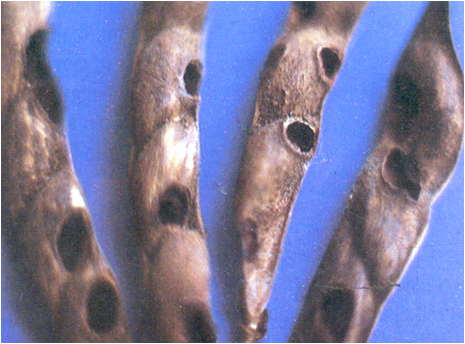 |
| Bore holes on the pod |
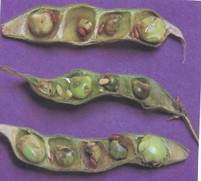 |
| Larva feeding the pod |
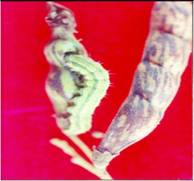 |
| Damaged pod |
|
| Top |
Blue butterfly
Symptom of Damage
- Buds, flowers and young pods with boreholes
- Presence of slug like caterpillar.
- Honey dew secretion with black ant movements
Identification of pest
Scientific Name - Lampides boeticus
- Larva – It is flat and slightly rounded; Pale green with a rough skin.
- Adult - moth is greyish blue with prominent black spots in the hind wings and a long tail; Ventral side of wings with numerous stripes and brown spots
Management Strategies
- Avoid dense and close planting
- Avoid early or late sowing
- Regular soil digging cause death of larvae and pupae
- Egg parasitoid, Trichogramma spp.,
- Larval parasitoids, Hyperencyrtus lucoenephila and Litrodromus crassipes
|
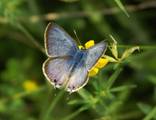 |
| |
|
| Top |
Grass blue butterfly
Symptom of Damage
- Buds, flowers and young pods with boreholes and presence of slug like caterpillar.
- Larval entry hole on the pod is plugged with excreta.
Identification of pest
Scientific Name - Euchrysops cnejus
- Larva - pale green or yellow with a red line and short black hairs on the body.
- Adult - butterfly is blue, medium sized with 5 black spots in the hind wings and two black spots in the inner margin.
Management Strategies
- ETL 10% affected parts
- Deep summer ploughing in 2-3 years to eliminate quiescent pupa.
- Early sowing, short duration varieties.
- Avoid closer plant spacing.
- Grow tall sorghum as comparison crop to serve as biological bird perches
- Collect and destroy larvae and adults to the extent possible
- Install pheromone traps at a distance of 50 m @ 5 traps/ha for each insect pest.
- Install Bird perches @ 50/ha.
- Setting of light traps (1 light trap/5 acre) to kill moth population.
- Control is achieved by releasing of Trichogramma chlionis at weekly intervals @1.5 lakh/ha/ week for four times.
- Conserve green lacewing, predatory stink bugs, spider, ants
- Bt @ 600 g, neem oil/ pungum oil 80 EC @ 2ml/lit
|
|
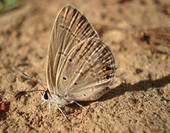 |
|
| Top |
Plume moth
Symptoms of damage
- Pin head size holes on pods
- Small spiny caterpillars and pupae seen on the pods
Identification of the pest
Scientific Name - Exelastis atomosa
- Larva - is greenish brown, fringed with radiating hairs and spines
- Adult - is delicate, brown coloured small moth with plumed wings
Management Strategies
ETL: 5/plant
- Bird perches 50/ha
- Mechanical collection of grown up larva and blister beetle
- Apply Neem oil 2%
|
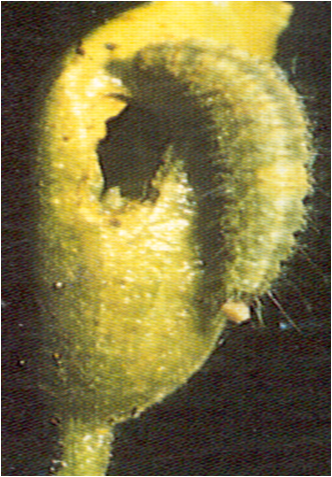 |
| Larva |
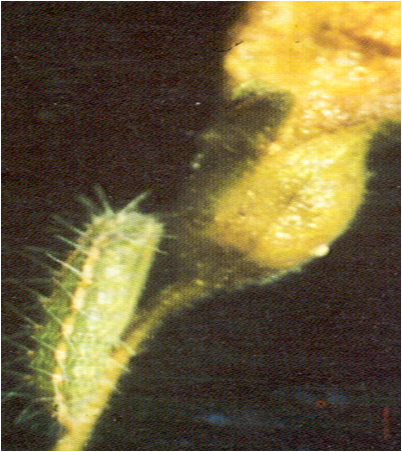 |
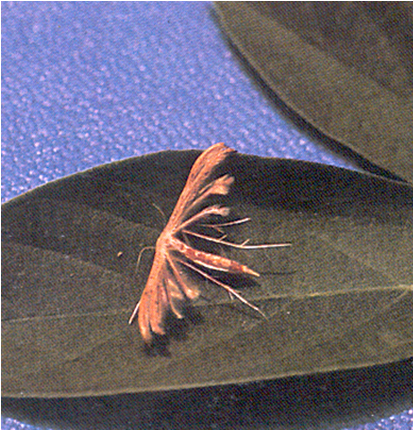 |
| Pupa |
Adult |
| |
|
| Top |
Spotted pod borer
Symptoms of damage
- Bore holes on the buds, flower or pods
- Infested pods and flowers are webbed together
Identification of the pest
Scientific Name - Maruca testulalis
- Larva - Greenish white with brown head. It has two pairs of dark spots on the back of each segment
- Adult - Forewings- light brown colour with white markings; Hindwings – white colour with brown markings at the lateral edge
Management Strategies
ETL: 5/plant
- Bird perches 50/ha
- Mechanical collection of grown up larva and blister beetle
- Apply Neem oil 2%
|
|
|
| Top |
Spiny pod borer
Symptoms of damage
- Dropping of flowers and young pods
- Older pods marked with a brown spot where a larvae has entered
Identification of the pest
Scientific Name - Etiella zinckenella
- Larva – greenish initially, turns pink before pupation
- It has 5 black spots on the prothorax
Management Strategies
ETL 10% affected parts
- Deep summer ploughing in 2-3 years to eliminate quiescent pupa.
- Early sowing, short duration varieties
- Avoid closer plant spacing
- Grow tall sorghum as comparison crop to serve as biological bird perches
- Install Bird perches @ 50/ha
- Setting of light traps (1 light trap/5 acre) to kill moth population
- Control is achieved by releasing of Trichogramma chlionis at weekly intervals @1.5 lakh/ha/ week for four times
- Conserve green lacewing, predatory stink bugs, spider, ants
|
|
| |
|
| Top |
Field bean pod borer
Symptoms of damage
Identification of the pest
Scientific Name - Adisura atkinsoni
- Larva - greenish having brown lateral marking
- It has humped anal segment
Management Strategies
- ETL 10% affected parts
- Deep summer ploughing in 2-3 years to eliminate quiescent pupa.
- Early sowing, short duration varieties.
- Avoid closer plant spacing.
- Grow tall sorghum as comparison crop to serve as biological bird perches
- Collect and destroy larvae and adults to the extent possible
- Install pheromone traps at a distance of 50 m @ 5 traps/ha for each insect pest.
- Install Bird perches @ 50/ha.
- Setting of light traps (1 light trap/5 acre) to kill moth population.
- Control is achieved by releasing of Trichogramma chlionis at weekly intervals @1.5 lakh/ha/ week for four times.
- Conserve green lacewing, predatory stink bugs, spider, ants
|
|
|
| Top |
Red gram pod fly
Symptoms of damage
- Dark brown encrustation on the pod wall
- Dry pods showing pin head size hole,
- Seeds shriveled, striped and partially eaten
Identification of the pest
Scientific Name - Melanagromyza obtusa
- Larva - greenish having brown lateral marking
- It has humped anal segment
- Moths are yellowish brown in colour
- Forewings - yellow coloured with ‘V’ shaped specks
- Adult
- Hindwings – has pale brown markings
- Management Put bird perches @ 50/ha
- Mechanical collection of grown up larva and blister beetle
Management Strategies
- Bird perches 50/ha
- Mechanical collection of grown up larva and blister beetle
- Apply Neem oil 2%
|
 |
|
| |
| |
|
| Top |
Stem fly
Symptoms of damage
- Drooping of the tender leaves and – seedling wilt
- Yellowing of young plants
- Stem become swollen and start ribbing where maggot and pupae are present
Identification of the pest
Scientific Name - Ophiomyia phaseoli
- Maggot- Small yellow coloured
- Adult -Tiny black fly
Management Strategies
- Timely sowing also minimizes the attack of the pest
|
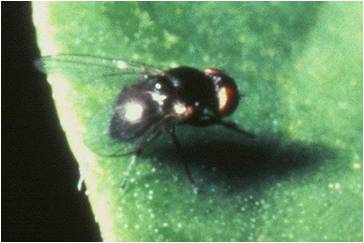 |
| Sap Feeders |
Pod bugs
Symptoms of damage
- Pods with black spots
- Shedding of green pods
- Poorly filled pods with shriveled grains inside
Identification of the pest
Scientific Name - Riptortus pedestris
- Brownish black and hemispherical
- Nymphs – resemble dark brown ants
Management Strategies
- Bird perches 50/ha
- Mechanical collection of grown up larva and blister beetle
- Apply Neem oil 2%
|
|
|
| Top |
Lab lab bug or Stink bug
Symptoms of damage
- Cluster on the plant parts and suck the sap
Identification of the pest
Scientific Name - Coptosoma cribraria
- Nymphs and Adult - sub globular, oval and greenish shield bug
- It has a characteristic buggy odour
|
|
|
| Top |
Bean Aphids
Symptoms of damage
- Leaves, inflorescence stalk and young pods covered with dark coloured aphids
- Honey dew secretion with black ant movements
Identification of the pest
Scientific Name - Aphis craccivora
- Nymphs and Adult – dark coloured with cornicles in the abdomen
|
|
|
| Top |
Leaf hopper
Symptoms of damage
- Leave mottled and yellowish in colour
- Green colour insects found under surface of leaves
Identification of the pest
Scientific Name - Empoasca kerri
- Adult – elongate, active, wedge shape, green insects
|
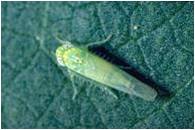 |
|
| Top |
Whitefly
Symptoms of damage
- Leave mottled and yellowish in colour
- vector of yellow mosaic virus
Identification of the pest
Scientific Name - Bemisia tabaci
- Adults -are small, yellow bodied insects with white wings which are densely covered with a waxy powder
- Nymphs and pupae -are black and round or oval. Pupae have marginal bristles
Management Strategies
- Shaking the infested plants over the vessels of oil and water or oily cloth gives most effective
|
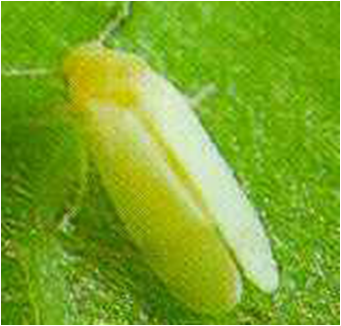 |
|
| |
|
| Top |
Eriyophid mite
Symptoms of damage
- Vector of red gram sterility mosaic virus
Identification of the pest
Scientific Name - Aceria cajani
- Nymphs & Adult – white in colour
- Very small microscopic and vermiform llike with two pairs of anteriorly located legs
Management Strategies
- Shaking the infested plants over the vessels of oil and water or oily cloth gives most effective
|
|
|
| Top |
Leaf folder
Symptoms of damage
Identification of the pest
Scientific Name - Anticarsia irrorata
- Larva- green coloured
- Adult – yellowish brown moth with an oblique black line on the wings
|
 |
| Larva |
 |
| Adult |
|
| Top |
Leaf Webber
Symptoms of damage
- Leaves rolled up apically and become white and dried up
Identification of the pest
Scientific Name - Eucosma critica
|
|
|
| Top |
Red gram leaf roller
Symptoms of damage
- Leaves folded together with tender shoots showing bore holes
Identification of the pest
Scientific Name - Caloptilia soyella
- Larva- stout, long, smooth yellow with brown head
|
|
|
| Top |
Lab lab leaf miner
Symptoms of damage
- Leaves with large irregular papery mines on the dorsal surface
Identification of the pest
Scientific Name - Cyphosticha coerulea
- Larva- orange coloured caterpillar
|
|
| |
| |
| Flower Feeder |
Blister beetle
Symptoms of damage
- The adult feeds voraciously on buds and flowers.
Identification of the pest
Scientific Name - Mylabris phalerata
- Eggs - are light yellowish in colour and cylindrical in shape.
- Larva - Young grubs are white in colour.
- Adult – Elytra are black in colour with a round orange spot and two transverse wavy orange bands across the wings.
Management Strategies
- Manual collection or collection with insect net and killing of adults in kerosenized water appears to be the only possible solution.
|
|
 |
|
| Top |
Blister beetle
Symptoms of damage
Identification of the pest
Scientific Name - Eublemma hemarrhoda
- Larva - is green with a black head and long white hairs on the body
- Adult
- Forewings – yellow colour with purple patches
- Hind wings -white
|
|
|
| Top |